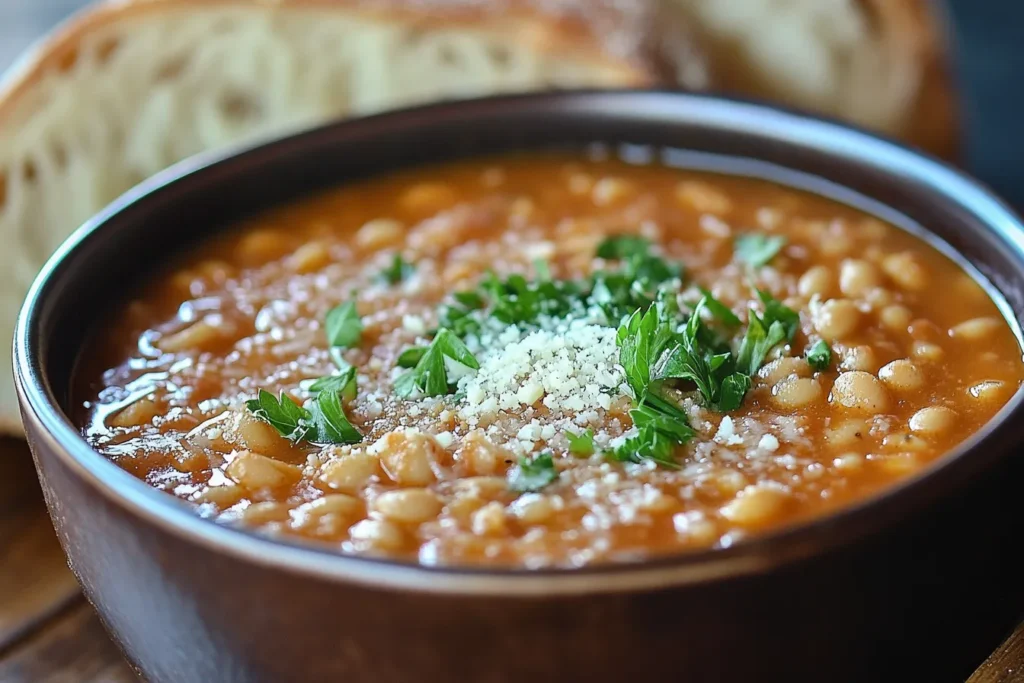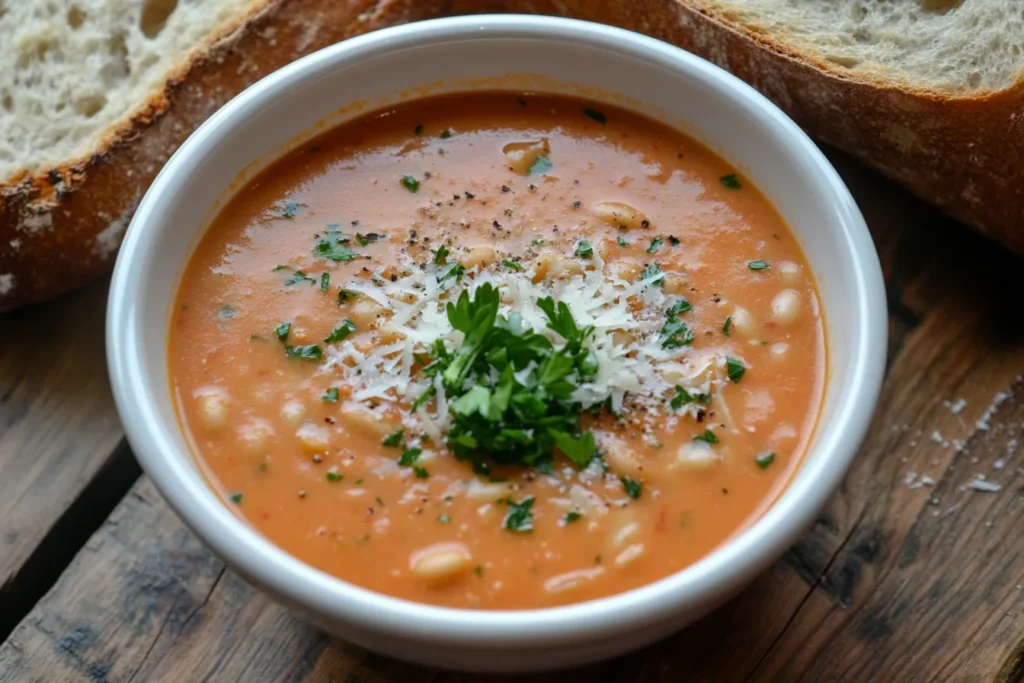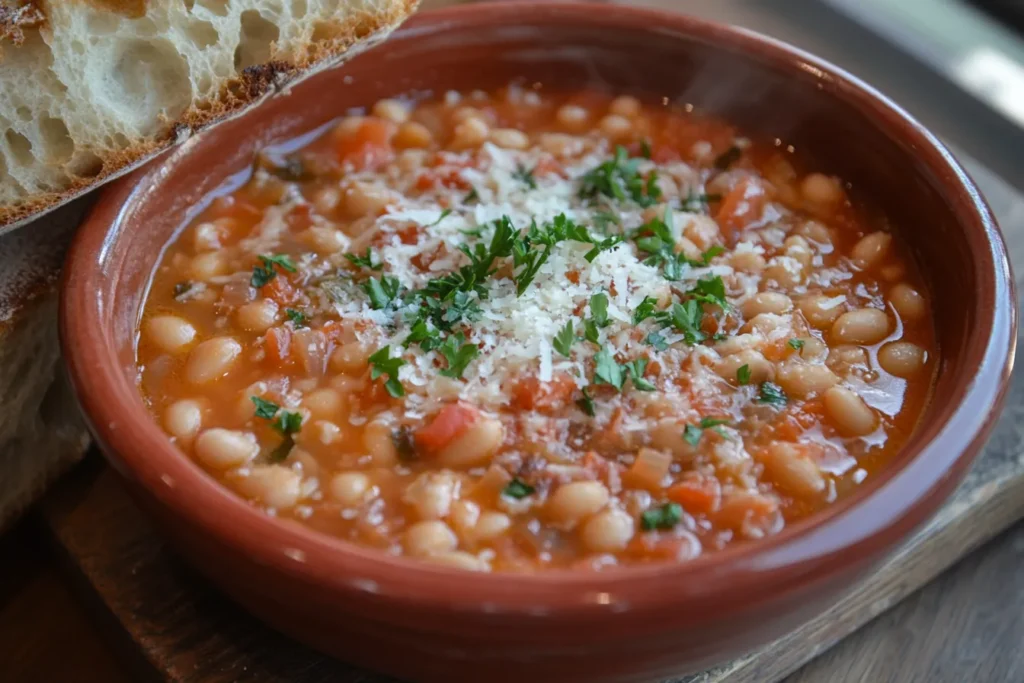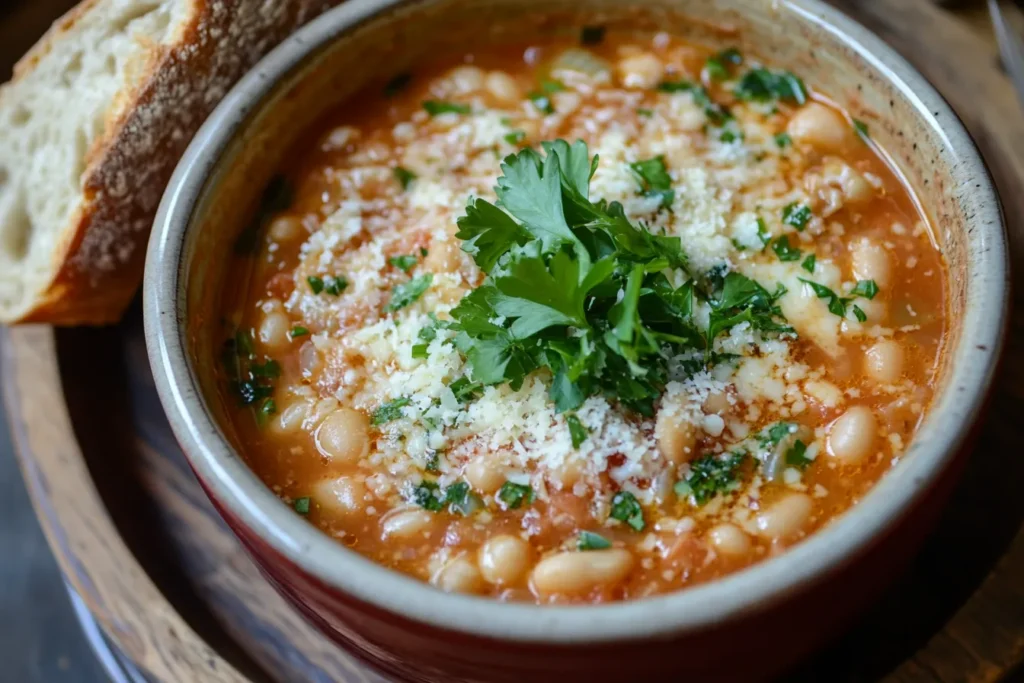Are you tired of meals that leave you feeling unsatisfied or missing that perfect touch? Imagine a dinner so comforting and delicious it feels like a warm embrace after a long day. That’s exactly what Pasta e Fagioli can bring to your table. It’s not just a soup—it’s a bowl of nostalgia, flavor, and harmony that’s as satisfying to make as it is to enjoy. Whether you’re craving a hearty dinner or looking for ways to elevate your everyday meals, this dish has everything you need to turn an ordinary evening into something special. Let’s dive into how you can make it your own!
List Of Contents
1. Introduction to Pasta e Fagioli Soup
Pasta e Fagioli, literally translating to “pasta and beans,” is a classic Italian dish beloved for its simplicity and versatility. This humble soup has evolved from a peasant meal to a staple in Italian restaurants worldwide. Originating as a way to stretch limited ingredients into a filling and nutritious meal, Pasta e Fagioli is a shining example of how simple cooking can produce extraordinary flavors.
Its cultural significance in Italian cuisine cannot be overstated. Pasta e Fagioli embodies the essence of comfort food, uniting families at the dinner table for generations. Its recipes vary from region to region and even from one household to another, making it a deeply personal dish that reflects local ingredients and traditions. Check out more recipes here.

2. The Origins of Pasta e Fagioli
Pasta e Fagioli, a dish steeped in history, can be traced back to Italy’s rural communities, where resources were often scarce, and creative cooking was not just valued but necessary. Consequently, this soup emerged as a versatile solution, crafted from whatever ingredients were readily available. For instance, dried beans, pasta scraps, and fresh herbs from the garden were frequently combined to create a meal that was both satisfying and resourceful.
Meanwhile, as the dish spread across different regions, unique interpretations began to emerge. For example, in areas like Veneto, Tuscany, and Campania, the recipe evolved to reflect local tastes and ingredients. In the North, creamier versions came to dominate, often featuring borlotti beans and milk to enhance richness. On the other hand, in the South, the soup adopted a tomato-based, slightly spicy character, showcasing the influence of Mediterranean flavors. Over time, and due to its affordability and adaptability, Pasta e Fagioli became a household staple, cherished not only for its flavor but also for its representation of Italy’s culinary ingenuity. Check out more recipes here.
3. Core Ingredients of Pasta e Fagioli
At its heart, Pasta e Fagioli is a simple soup that relies on high-quality ingredients to shine. Key components include:
- Pasta: Ditalini, small shells, or broken spaghetti are common choices, though regional variations may call for different shapes.
- Beans: Cannellini or borlotti beans are traditional, each contributing a unique texture and flavor profile. Beans act as the protein source in this dish, making it both hearty and nutritious.
The interplay between these ingredients creates a balanced, satisfying meal, with beans offering creaminess and pasta providing chewiness. Check out more recipes here.
4. The Role of Broth in Pasta e Fagioli
The broth forms the foundation of the soup, setting the tone for its flavor profile. Home cooks can choose from:
- Vegetable Broth: Ideal for a light and fresh flavor, perfect for vegetarian versions.
- Chicken or Beef Broth: These add a rich and robust depth, complementing the beans and pasta.
The broth you choose determines whether the soup is mild or savory, but in every case, it acts as the unifying element for the dish. Check out more recipes here.
5. Aromatics and Flavor Enhancers
Aromatics such as onions, garlic, and celery are the backbone of Pasta e Fagioli. These ingredients are typically sautéed in olive oil to release their flavors before layering in the other components. Adding herbs like rosemary, thyme, or bay leaves infuses the broth with earthy undertones, while a sprinkle of parsley at the end brightens the dish.
- Garlic: Adds a hint of spice and warmth.
- Rosemary and Thyme: Elevate the soup with herbal complexity.
- Celery and Onions: Contribute subtle sweetness and texture.
6. Proteins in Pasta e Fagioli
While traditionally a vegetarian dish, many variations include pancetta or bacon for a smoky, savory dimension. For a meat-free version, substitutions like smoked paprika or liquid smoke can mimic these flavors without compromising the soup’s depth and richness.
Vegetarian Alternatives:
- Adding extra aromatics or caramelizing onions can intensify flavor.
- Incorporating mushrooms provides an umami punch.
7. Seasoning and Spices
The perfect Pasta e Fagioli balances saltiness, acidity, and heat. Here’s how:
- Black Pepper: Adds a warming spice.
- Red Chili Flakes: Offer a kick of heat for spice lovers.
- Salt and Acid: Adjust as needed to enhance the natural flavors of the beans and broth.
Balancing these elements ensures that each bite is vibrant and flavorful without overwhelming the palate.
8. The Role of Olive Oil
Olive oil is more than just a cooking medium in Pasta e Fagioli; it is a key flavor enhancer. High-quality extra virgin olive oil brings a fruity richness to the dish. A drizzle added just before serving elevates the soup, enhancing its silky texture.
Tips for Using Olive Oil:
- Opt for cold-pressed olive oil for the best flavor.
- Avoid overcooking to preserve its aromatic qualities.
9. Variations of Pasta e Fagioli

Pasta e Fagioli’s beauty lies in its adaptability. Across Italy, regional differences abound:
- Northern Italy: Creamier versions featuring milk or cream.
- Southern Italy: Tomato-based broths with chili flakes for heat.
Modern interpretations include gluten-free options with chickpea pasta or high-protein versions incorporating quinoa. These adaptations show how the dish continues to evolve while honoring its traditional roots.
10. Health Benefits of Pasta e Fagioli
Pasta e Fagioli isn’t just comforting; it’s also nutritionally balanced. The beans provide fiber and protein, while pasta adds complex carbohydrates for sustained energy.
Tips for a Healthier Version:
- Use whole-grain pasta for added fiber.
- Swap canned beans with soaked, dried beans to reduce sodium.
- Incorporate more vegetables like zucchini or spinach for added nutrients.
11. How to Choose the Right Pasta for Pasta e Fagioli
The type of pasta used in Pasta e Fagioli plays a critical role in achieving the perfect texture and consistency. Traditionally, short pasta shapes like ditalini, elbow macaroni, or small shells are preferred because they blend seamlessly with the beans and broth. However, the choice of pasta is flexible based on regional traditions or personal preference.
Tips for Cooking Pasta Perfectly:
- Cook Pasta Al Dente: Overcooked pasta can become mushy when added to the soup. Aim for a slightly firm texture.
- Cook Separately, If Needed: To prevent the pasta from absorbing too much broth, you can cook it separately and combine it just before serving.
- Experiment with Gluten-Free Options: If gluten sensitivity is a concern, try chickpea or lentil pasta for a high-protein alternative.
Pasta’s role is to add body and heartiness to the soup while complementing the creamy texture of the beans.
12. Preparing the Beans for Pasta e Fagioli
Beans are the star ingredient of this dish, offering both flavor and nutritional value. While canned beans are convenient, many chefs prefer dried beans for their superior texture and taste.
Canned vs. Dried Beans:
- Canned Beans: Quick and easy, but rinse them to reduce excess sodium.
- Dried Beans: Require soaking and cooking but yield a more authentic texture.
Tips for Preparing Dried Beans:
- Pre-Soak: Soaking beans overnight reduces cooking time and improves digestibility.
- Cook with Aromatics: Simmer beans with garlic, bay leaves, or rosemary to infuse flavor.
Properly prepared beans add a creamy, melt-in-your-mouth quality to the soup that complements the chewy pasta.
13. Building the Base for the Soup
Creating a flavorful base is absolutely crucial for crafting a standout Pasta e Fagioli. To begin, start by sautéing aromatics such as onions, garlic, and celery in olive oil. This step not only releases their natural flavors but also sets the stage for the rich, savory profile of the soup. However, make sure to use medium heat; burning the garlic can result in an unpleasant bitterness that undermines the dish’s delicate balance.
Next, it’s important to deglaze the pan, which involves adding a splash of white wine or vinegar. This technique scrapes up any browned bits stuck to the bottom of the pan, incorporating them into the soup and intensifying the overall flavor. Meanwhile, the acidity from the wine or vinegar adds a bright, tangy element that balances the richness of the broth.
Finally, move on to incorporating tomatoes, which are a key component of the soup’s foundation. Opt for crushed tomatoes or a dollop of tomato paste for a deeper, more concentrated flavor. This layering of ingredients ensures the soup develops a complex, well-rounded flavor from the very beginning, making it both comforting and memorable.
14. Cooking Techniques for Pasta e Fagioli
The secret to a perfect Pasta e Fagioli lies in its cooking process. Simmering allows flavors to meld while maintaining the right consistency.
Techniques to Master:
- Control the Consistency: Simmer longer for a thicker soup or add extra broth for a lighter version.
- Cook Pasta Separately: Prevent overcooking by combining pasta with the soup just before serving.
- Mash Some Beans: For a creamier texture, mash a portion of the beans directly into the broth.
These methods ensure the soup is both comforting and visually appealing.
15. The Art of Balancing Flavors
Balancing flavors is where Pasta e Fagioli transforms from a good soup into a spectacular one. Key elements include salt, acidity, and heat.
Flavor Tips:
- Season Gradually: Add salt and pepper in stages to avoid over-seasoning.
- Use Acidity: A splash of vinegar or a squeeze of lemon brightens the soup and balances richness.
- Incorporate Heat: Red chili flakes provide a subtle kick, enhancing the overall flavor.
The aim is to craft a balanced bowl where each bite is seasoned to perfection.
16. Serving Pasta e Fagioli
Presentation matters when serving this classic dish. Simple garnishes and thoughtful plating can elevate the experience.
Serving Tips:
- Add Fresh Herbs: Sprinkle parsley or basil on top for a pop of color and freshness.
- Use Parmesan: Grated cheese adds savory depth.
- Serve with Bread: A slice of crusty Italian bread or focaccia is perfect for dipping.
These small touches turn a humble soup into a restaurant-quality meal.
17. Popular Accompaniments to Serve With Pasta e Fagioli
Accompanying Pasta e Fagioli with complementary side dishes enhances the meal, turning it into a complete and satisfying dining experience. To begin with, serving the soup with bread is a timeless choice. Choices such as focaccia, ciabatta, or a crusty Italian loaf are ideal for soaking up the rich broth, offering a delightful crunch and chewiness that pairs beautifully with the soup creamy texture.
In addition, a light salad offers balance by introducing fresh, crisp flavors that contrast beautifully with the soup’s hearty profile. For instance, a peppery arugula salad dressed in lemon vinaigrette cuts through the richness, while a classic caprese salad—with juicy tomatoes, fresh mozzarella, and fragrant basil—adds a touch of elegance and color.
Finally, no Italian meal would be complete without wine to enhance the flavors of the dish. A medium-bodied red wine like Chianti or Montepulciano is an excellent choice, as its earthy and fruity notes harmonize with the soup’s rustic ingredients. Alternatively, a crisp white wine like Pinot Grigio works well for those who prefer a lighter pairing.
Altogether, these accompaniments not only enhance the dish but also honor its authentic, rustic origins, creating a meal that is both comforting and memorable.
18. Storing and Reheating Pasta e Fagioli
Pairing Pasta e Fagioli with the right side dishes not only elevates the meal but also creates a more complete and satisfying dining experience. To begin with, serving the soup alongside a variety of bread options like focaccia, ciabatta, or a crusty Italian loaf is a must. These breads are perfect for soaking up the flavorful broth and add a delightful textural contrast to the creamy soup.
In addition, a light salad makes an excellent accompaniment, as it balances the soup’s heartiness with fresh, crisp flavors. For example, an arugula salad with lemon vinaigrette or a classic caprese salad featuring ripe tomatoes, mozzarella, and basil works wonderfully to refresh the palate.
Finally, no Italian-inspired meal is complete without a thoughtful wine pairing. A medium-bodied red wine, such as Chianti or Montepulciano, pairs beautifully with the soup, enhancing its rich, rustic flavors. Alternatively, a crisp white wine like Pinot Grigio offers a lighter option for those who prefer less intensity.
Together, these accompaniments honor the dish’s rustic roots while creating a harmonious and enjoyable dining experience.
19. Common Mistakes to Avoid
Even seasoned cooks can face challenges when preparing Pasta e Fagioli. However, by being mindful of common pitfalls, you can consistently create a flavorful and authentic dish.

Common Mistakes to Avoid
- Overcooking the Pasta: One of the most frequent errors is overcooking the pasta, which results in a mushy and unappealing texture. To avoid this, cook the pasta al dente and, if possible, add it to the soup just before serving.
- Using the Wrong Beans: The type of beans used can significantly affect the soup’s flavor and texture. Traditional varieties like cannellini or borlotti beans are essential for achieving the dish’s authentic taste. Substituting with other types of beans, like black or kidney beans, can alter the soup’s intended character.
- Skipping Aromatics: Aromatics like onions, garlic, and celery are the backbone of the soup’s flavor. Neglecting these ingredients can lead to a flat, uninspired broth. Sautéing these aromatics in olive oil at the start ensures the soup has a rich, aromatic base.
By addressing these potential missteps, you can guarantee that each bowl of Pasta e Fagioli is as delicious and satisfying as it was meant to be, capturing the essence of traditional Italian cuisine.
20. Frequently Asked Questions About Pasta e Fagioli
Q1: Can Pasta e Fagioli be made gluten-free?
Yes, simply use gluten-free pasta or substitute with a grain like quinoa.
Q2: What are the best vegetarian substitutions for pancetta?
Smoked paprika or caramelized onions can replicate the depth of flavor.
Q3: Can I freeze Pasta e Fagioli?
Yes, but store the pasta separately to maintain its texture.
Q4: How do I make the soup creamier?
Mash some beans or stir in a splash of cream.
Q5: What’s the best pasta shape for this soup?
Short pasta like ditalini or elbow macaroni works best.
Q6: Can I use canned beans for the recipe?
Absolutely, just rinse them thoroughly to remove excess sodium.
Q7: What type of broth is ideal?
Vegetable broth for vegetarians; chicken or beef for added richness.
Q8: How do I avoid overcooking the pasta?
Cook it separately and add to the soup just before serving.
Q9: Is Pasta e Fagioli healthy?
Yes, it’s high in fiber and protein, especially with whole-grain pasta.
Q10: What wine pairs best with the soup?
Medium-bodied reds like Chianti or even a crisp white like Pinot Grigio.
21. Recipe: Classic Pasta e Fagioli
Creating a traditional Pasta e Fagioli is a rewarding experience, bringing the essence of Italian cooking to your kitchen. This recipe follows the authentic method, highlighting the simplicity and heartiness of this classic dish.
Ingredients:
- 1 cup ditalini pasta
- 1 cup cannellini beans (soaked and cooked or canned, rinsed)
- 2 tbsp extra virgin olive oil
- 1 medium onion, finely chopped
- 2 cloves garlic, minced
- 1 medium carrot, diced
- 1 stalk celery, diced
- 1 can (14 oz) crushed tomatoes
- 4 cups chicken or vegetable broth
- 1 sprig rosemary
- 1 tsp red chili flakes (optional)
- Salt and pepper, to taste
- Grated Parmesan cheese and chopped parsley for garnish
Directions:
- Prepare Aromatics: Heat olive oil in a pot. Sauté onions, garlic, carrot, and celery until softened.
- Build the Base: Add crushed tomatoes and cook for 5 minutes, allowing the flavors to meld.
- Simmer: Add broth, beans, and rosemary. Simmer for 20 minutes.
- Cook Pasta: Separately boil the pasta until al dente. Drain and set aside.
- Combine: Add cooked pasta to the soup. Adjust seasoning with salt, pepper, and chili flakes.
- Serve: Ladle soup into bowls and garnish with Parmesan and parsley.
This version highlights the traditional flavors that make Pasta e Fagioli timeless.
22. Recipe: Vegetarian Pasta e Fagioli
For a meat-free variation, this vegetarian recipe uses flavorful substitutes to achieve the same depth as the classic version.
Key Adjustments:
- Replace chicken broth with vegetable broth.
- Incorporate mushrooms for umami.
- Use smoked paprika for a hint of smokiness.
Directions:
Follow the steps above, substituting the mentioned ingredients. This version retains the rich, comforting flavors of the original while staying vegetarian-friendly.
23. Recipe: Quick and Easy Pasta e Fagioli
Pressed for time? This streamlined recipe delivers the same comforting flavors in under 30 minutes.
Ingredients:
- 1 can (14 oz) cannellini beans
- 1 can (14 oz) crushed tomatoes
- 4 cups store-bought broth
- 1 cup small pasta (like ditalini)
- 2 tbsp olive oil
- 1 tsp dried Italian herbs
Directions:
- Sauté Aromatics: Heat olive oil and sauté garlic and onion.
- Combine Ingredients: Add tomatoes, beans, and broth. Simmer for 10 minutes.
- Cook Pasta: Add pasta directly to the pot and cook until tender.
- Serve: Garnish with herbs and Parmesan.
This version is perfect for weeknight dinners, maintaining the essence of Pasta e Fagioli with minimal effort.
24. Exploring Regional Variations
Italy’s diverse regions bring unique twists to Pasta e Fagioli. Here are some notable differences:

- Northern Italy: Creamy versions made with milk or cream and borlotti beans.
- Southern Italy: Tomato-forward recipes, spiced with red chili flakes.
- Veneto: Often includes pasta mista (mixed pasta pieces) for texture.
- Tuscany: Incorporates Tuscan kale or cavolo nero for added depth.
Each region reflects its culinary heritage, proving that there’s no one “correct” way to make this dish.
25. Customizing Pasta e Fagioli for Dietary Needs
Pasta e Fagioli can be tailored to fit various dietary preferences:
- Low-Carb: Swap pasta with zucchini noodles or cauliflower rice.
- Vegan: Use vegetable broth and skip the Parmesan cheese, or use a vegan substitute.
- High-Protein: Add chickpea pasta or a spoonful of nutritional yeast for protein.
This adaptability makes it a dish that everyone can enjoy.
26. Pasta e Fagioli for Meal Prep
Pasta e Fagioli is an excellent choice for meal prepping. It stores well, and the flavors often deepen over time.
Tips for Meal Prep:
- Store Separately: Keep pasta and soup in separate containers to avoid soggy pasta.
- Portioning: Divide into single servings for easy grab-and-go meals.
- Freezing: Freeze the soup base (without pasta) for up to three months.
Proper planning ensures you always have a comforting meal on hand.
27. The Evolution of Pasta e Fagioli Over Time
While Pasta e Fagioli has remained a staple in Italian households, it has evolved significantly. Modern variations reflect:
- Global Influences: Incorporation of non-traditional ingredients like quinoa or coconut milk.
- Health Trends: Focus on whole-grain pasta and plant-based broths.
- Restaurant Adaptations: Gourmet versions with truffle oil or exotic herbs.
These changes show how a humble peasant dish has embraced contemporary culinary trends.
28. Famous Pasta e Fagioli Recipes in Restaurants
Several chefs and restaurants have reimagined Pasta e Fagioli:
- Giada De Laurentiis: Known for her light, tomato-heavy version.
- Mario Batali: Adds pancetta and uses high-quality Parmigiano-Reggiano.
- Olive Garden: Offers a hearty, Americanized take with Italian sausage.
These adaptations have introduced Pasta e Fagioli to audiences beyond Italy, cementing its status as a global favorite.
29. Celebrating Pasta e Fagioli Day
Italy and Italian-American communities often celebrate this beloved dish with special events.
- Community Gatherings: Local festivals in Italian towns feature competitions and shared meals.
- Restaurant Promotions: Many Italian restaurants offer discounted or special versions of Pasta e Fagioli on this day.
Celebrating Pasta e Fagioli Day is a testament to the dish’s enduring cultural and culinary significance.
30. Conclusion and Final Thoughts
Pasta e Fagioli’s enduring popularity lies in its simplicity, adaptability, and comforting flavors. From its humble origins as a peasant dish to its status as a global culinary icon, it remains a testament to the power of good ingredients and time-tested techniques.
Whether you stick to the classic recipe or explore modern twists, Pasta e Fagioli is a dish that welcomes experimentation. Its warmth and versatility ensure it will continue to be a favorite for generations to come.
More FAQs:
Q1: Can I make Pasta e Fagioli creamy without cream?
Yes, mash some beans or blend a portion of the soup.
Q2: What’s the best way to reheat leftovers?
Reheat gently on the stovetop, adding broth to loosen consistency.
Q3: Is it possible to make this dish spicy?
Yes, add red chili flakes or a splash of hot sauce.
Q4: Can I skip the tomatoes?
Yes, Northern Italian versions often forgo tomatoes for a creamier broth.
Q5: How do I prevent the soup from thickening too much?
Add broth or water as needed during reheating.
Q6: Can I use other herbs besides rosemary?
Thyme, bay leaves, or sage are great alternatives.
Q7: What’s the best way to serve this dish for a party?
Serve in bread bowls or garnish with a Parmesan crisp.
Q8: Can I add other vegetables?
Absolutely! Spinach, zucchini, or kale make excellent additions.
Q9: What beans can I substitute for cannellini?
Navy beans, Great Northern beans, or chickpeas work well.
Q10: How do I achieve a smoky flavor without meat?
Smoked paprika or a drop of liquid smoke is a perfect vegetarian-friendly option.
